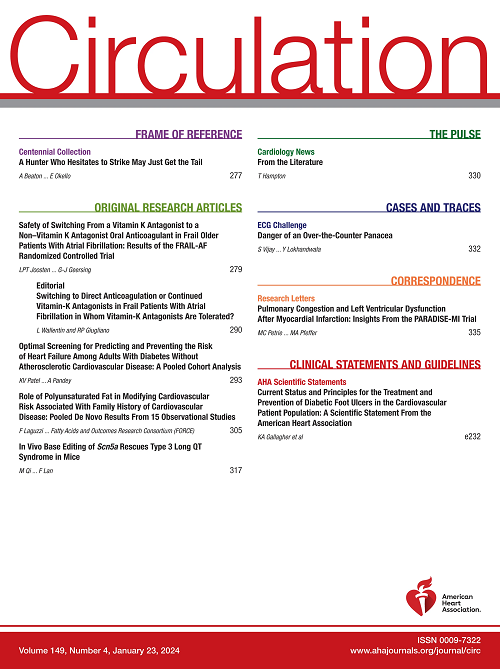ctnt介导的肌瘤-线粒体通讯中断导致扩张性心肌病。
IF 38.6
1区 医学
Q1 CARDIAC & CARDIOVASCULAR SYSTEMS
引用次数: 0
摘要
背景扩张型心肌病(DCM)在很大程度上受遗传因素的影响。肌节的功能与其他细胞器有着复杂的联系,尤其是肌节与线粒体之间的相互调节。线粒体应激失调与DCM进展有关,但机制尚不清楚。在这项研究中,我们研究了cTnT(心脏肌钙蛋白T)失调对DCM中肌瘤-线粒体通讯的影响。方法本研究使用来自DCM家族队列的诱导多能干细胞(iPSCs),利用CRISPR-Cas9基因组编辑技术纠正iPSCs中TNNT2 (c.A553G)序列变异。随后建立了含有(p.K192E)序列变异的敲入小鼠模型,该模型相当于人类cTnT (p.K185E)序列变异。在ipsc衍生的心肌细胞、ipsc衍生的心脏类器官和小鼠中分析病理表型。RNA测序、代谢物谱分析和共免疫沉淀质谱分析被用于阐明分子机制。结果通过全外显子组测序,我们在家族性DCM队列中发现了一种新的cTnT致病变异(p.K185E)作为因果序列变异。在来自DCM患者的ipsc来源的心肌细胞中,我们观察到肌节紊乱和线粒体断裂伴有严重的线粒体功能障碍。cTnT (p.K185E)与14-3-3蛋白之间的相互作用减弱,导致14-3-3蛋白与肌肉结构分离。游离14-3-3蛋白异常参与RAS/RAF1信号轴,驱动p44/42激酶异常激活,最终导致线粒体裂变调节因子DRP1(动力蛋白相关蛋白1)和MFF(线粒体裂变因子)磷酸化。这些观察结果在ipsc衍生的心脏类器官中得到了重复。携带同源cTnT序列变异的敲入小鼠忠实地再现了人类DCM的标志性特征,包括心功能障碍、心室扩张、肌体紊乱和线粒体断裂。线粒体裂变抑制剂Mdivi-1在体内减轻了DCM表型。我们的研究结果揭示了DCM的一种新的致病机制,表明cTnT (p.K185E)序列变异通过削弱cTnT与14-3-3蛋白之间的相互作用,破坏肌瘤与线粒体的通讯,从而通过过度激活14-3-3蛋白介导的RAS/RAF1-p44/42-DRP1/MFF信号轴,加速线粒体断裂。因此,针对14-3-3蛋白和p44/42激酶活性的治疗可能是治疗DCM和其他与线粒体动力学异常相关的心脏病的一种有希望的策略。本文章由计算机程序翻译,如有差异,请以英文原文为准。
Disruption of cTnT-Mediated Sarcomere-Mitochondrial Communication Results in Dilated Cardiomyopathy.
BACKGROUND
Dilated cardiomyopathy (DCM) is substantially influenced by genetic factors. Sarcomere function is intricately associated with other organelles, particularly the reciprocal regulation between sarcomeres and mitochondria. Mitochondrial stress dysregulation is linked to DCM progression, yet mechanisms remain unclear. In this study, we investigated the effects of cTnT (cardiac troponin T) dysregulation on sarcomere-mitochondrial communication in DCM.
METHODS
Induced pluripotent stem cells (iPSCs) derived from a DCM family cohort were used in this study, and CRISPR-Cas9 genome editing was used to rectify the TNNT2 (c.A553G) sequence variation in iPSCs. A knock-in mouse model harboring the (p.K192E) sequence variation, equivalent to the human cTnT (p.K185E) sequence variation, was subsequently established. The pathological phenotypes were analyzed in iPSC-derived cardiomyocytes, iPSC-derived cardiac organoids, and mice. RNA sequencing, metabolite profiling, and coimmunoprecipitation mass spectrometry were used to elucidate the molecular mechanisms.
RESULTS
Through whole exome sequencing, we identified a novel pathogenic variant in cTnT (p.K185E) as the causal sequence variation in a familial DCM cohort. In iPSC-derived cardiomyocytes from patients with DCM, we observed sarcomere disarray and mitochondrial fragmentation accompanied by severe mitochondrial dysfunction. The diminished interaction between cTnT (p.K185E) and 14-3-3 proteins resulted in the dissociation of 14-3-3 proteins from sarcomeric structures. The free 14-3-3 proteins aberrantly engaged in the RAS/RAF1 signaling axis, driving aberrant p44/42 kinase activation that culminated in the phosphorylation of mitochondrial fission regulators DRP1 (dynamin-related protein 1) and MFF (mitochondrial fission factor). These observations were replicated in iPSC-derived cardiac organoids. The knock-in mice bearing the orthologous cTnT sequence variation faithfully recapitulated the hallmark features of human DCM, including cardiac dysfunction, ventricular dilatation, sarcomeric disarray, and mitochondrial fragmentation. Mdivi-1, a mitochondrial fission inhibitor, alleviated DCM phenotypes in vivo.
CONCLUSIONS
Our findings delineate a novel pathogenic mechanism underlying DCM, demonstrating that cTnT (p.K185E) sequence variation disrupts sarcomere-mitochondrial communication by weakening the interaction between cTnT and 14-3-3 proteins, thereby accelerating mitochondrial fragmentation through excessive activation of the 14-3-3 protein-mediated RAS/RAF1-p44/42-DRP1/MFF signaling axis. Therefore, therapeutic targeting of 14-3-3 proteins and p44/42 kinase activity may represent a promising strategy for DCM and other cardiac diseases associated with aberrant mitochondrial dynamics.
求助全文
通过发布文献求助,成功后即可免费获取论文全文。
去求助
来源期刊

Circulation
医学-外周血管病
CiteScore
45.70
自引率
2.10%
发文量
1473
审稿时长
2 months
期刊介绍:
Circulation is a platform that publishes a diverse range of content related to cardiovascular health and disease. This includes original research manuscripts, review articles, and other contributions spanning observational studies, clinical trials, epidemiology, health services, outcomes studies, and advancements in basic and translational research. The journal serves as a vital resource for professionals and researchers in the field of cardiovascular health, providing a comprehensive platform for disseminating knowledge and fostering advancements in the understanding and management of cardiovascular issues.
 求助内容:
求助内容: 应助结果提醒方式:
应助结果提醒方式:


